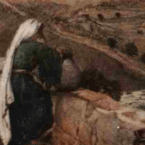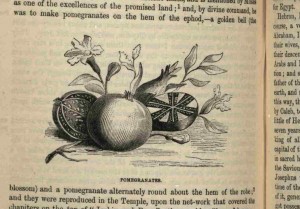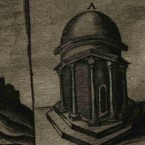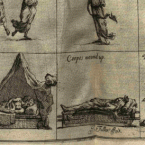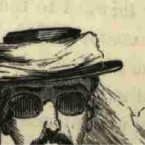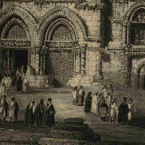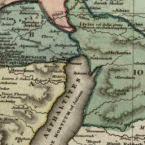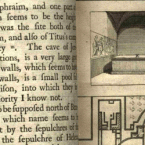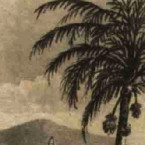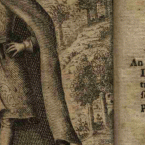Palestine as Scene in Religious History
In this display case, illustration borders on spirituality, religious history, and tourism, while the glamour of ancient religious identification obscures Palestine as a real place in the present. The Christian authors of these books imagined themselves as revenants to Palestine, but they were also shut out from objective views of the place. For them, Palestine itself was already an illustration of a book, the Bible. Some seem to have thought that the Bible, as greatest of great books, must surely also be set in the best travel destination, highlighting the affinities between pilgrimage, looking at books, and modern travel.
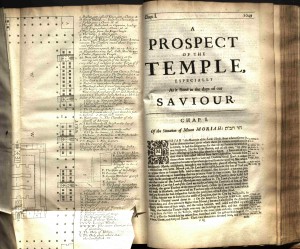 Donated, as an inscription notes, to Knox College in 1861 by John Taylor, DD, John Lightfoot’s large miscellany of religious and historical observations relies heavily on the Old Testament, and is generally preoccupied with Jewish culture. In his dedication to Mary Princess of Orange, the editor admits that “although the Author be in English, yet not only the meanness, but also the unsuitableness of such a present to Your Highness, being so full of Hebrew and Chronological Learning, may seem to want excuse enough.” Lightfoot deemed that the Philosemitism of learned Protestant culture needed countering with emphatic Englishness.
Donated, as an inscription notes, to Knox College in 1861 by John Taylor, DD, John Lightfoot’s large miscellany of religious and historical observations relies heavily on the Old Testament, and is generally preoccupied with Jewish culture. In his dedication to Mary Princess of Orange, the editor admits that “although the Author be in English, yet not only the meanness, but also the unsuitableness of such a present to Your Highness, being so full of Hebrew and Chronological Learning, may seem to want excuse enough.” Lightfoot deemed that the Philosemitism of learned Protestant culture needed countering with emphatic Englishness.
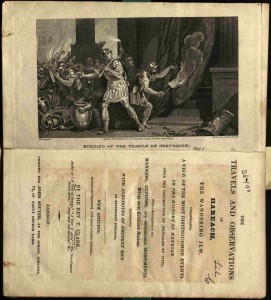
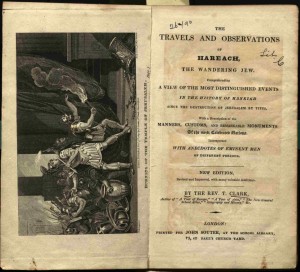 The frontispiece image of the burning of ancient Jerusalem that opens this small book highlights the conflation of traveling in the past and in place that so frequently occurred when British subjects visited the region they called the Holy Land. This historical action shot displays a version of history that is legible according to hegemonic codes of information. Its constituency, however, may not necessarily be limited to London: this book is also labeled with a bookplate that identifies a bookstore likely in Toronto, reinforcing the notion that travel books are hinges between multiple places, including their readers’ locations.
The frontispiece image of the burning of ancient Jerusalem that opens this small book highlights the conflation of traveling in the past and in place that so frequently occurred when British subjects visited the region they called the Holy Land. This historical action shot displays a version of history that is legible according to hegemonic codes of information. Its constituency, however, may not necessarily be limited to London: this book is also labeled with a bookplate that identifies a bookstore likely in Toronto, reinforcing the notion that travel books are hinges between multiple places, including their readers’ locations.
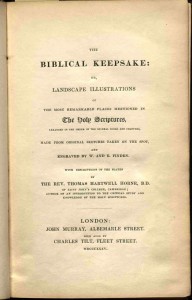 The Fisher collection holds multiple editions of this keepsake. While the illustrations and text were clearly printed from the same setting for each edition, the print qualities vary widely: one edition is small with modest design values and was clearly intended to be cheap as well as portable, while the double-volume organization, extremely wide margins and gilt pages of another increase its size and expense.
The Fisher collection holds multiple editions of this keepsake. While the illustrations and text were clearly printed from the same setting for each edition, the print qualities vary widely: one edition is small with modest design values and was clearly intended to be cheap as well as portable, while the double-volume organization, extremely wide margins and gilt pages of another increase its size and expense.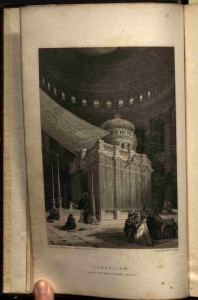 These varieties of format mirror the anticipated audiences and implied uses of these books, and show that the region could be both dressed up and down in the minds of nineteenth-century publishers.
These varieties of format mirror the anticipated audiences and implied uses of these books, and show that the region could be both dressed up and down in the minds of nineteenth-century publishers.
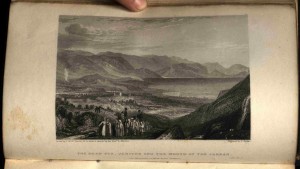 This book also contains one
This book also contains one
of the earliest references in this exhibit to an illustrator
by name, noteworthy because the crafts of design (among which illustration keeps an uneasy place) were slowly garnering the status of both art and profession through the period of this exhibit. Naming the illustrator shifts some of the authority for the book away from its author, but also, in a religious works such as this one, represents a stark contrast with the practices of medieval craftspeople who went unnamed to avoid seeming to detract from the glory of God.
W. H. Bartlett, the artist and author of the more secular works Walks about Jerusalem and Jerusalem Revisited also illustrated this religious view of Palestine, suggesting that, like a colonizing miner or trader, an artist in the period might find multiple ways of capitalizing on having visited the region. The frontispiece engraving 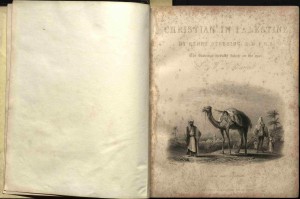 of this luxury mid-century work solidifies some of the visual clichés that came to be regularly associated with Palestine—camels and palm trees. In this case human figures identifiable as Arab because of their style of robes are also present, but, as is typical in British views of Palestine, they are not named or ascribed personal characteristics. In this recurring iconography, Palestine is signified as a relation between an animal, a form of plant life, and an impersonal figure. Like a logo, this kind of visual shorthand to indicate a location invites viewers into a sense of quick knowledge of a place with which they have no real intimacy, and so is a reminder of the challenges that real landscape poses to epistemological possession.
of this luxury mid-century work solidifies some of the visual clichés that came to be regularly associated with Palestine—camels and palm trees. In this case human figures identifiable as Arab because of their style of robes are also present, but, as is typical in British views of Palestine, they are not named or ascribed personal characteristics. In this recurring iconography, Palestine is signified as a relation between an animal, a form of plant life, and an impersonal figure. Like a logo, this kind of visual shorthand to indicate a location invites viewers into a sense of quick knowledge of a place with which they have no real intimacy, and so is a reminder of the challenges that real landscape poses to epistemological possession.
This extensive but compact book contains many illustrations 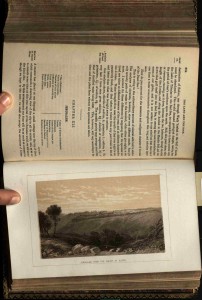 set into the text, as well as plates devoted to natural history and landscape views. The gold-embossed cover and a frontispiece bookplate commemorate the bestowal of the book as a prize at the North London Collegiate School.
set into the text, as well as plates devoted to natural history and landscape views. The gold-embossed cover and a frontispiece bookplate commemorate the bestowal of the book as a prize at the North London Collegiate School.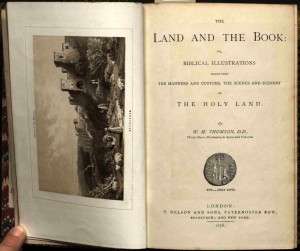
estine will always have to the ancient
Judeo-Christian texts, as an object it also signifies the curious relation between faith and knowledge. That this book about the land of Palestine was bestowed as a prize presumably for lessons well-learned, for knowledge, recalls the parallels between admitting knowledge of a place and awarding property.
A quotation from an eighteenth-century Bishop serves as the epigraph to Sir Richard Temple’s luxury edition, though it has a gold embossed menorah and Hebrew lettering on its cover. This lavishness of the imprint is paralleled by the paper spent on its heavy leading and wide margins. This sumptuousness of its pages is not reflected in ornamentation, however, and save for a few William Morris capitals and asymmetries, the layout of the book maintains an austere neoclassicism. This restraint does not diminish the success of the book as an objet, a status that its brilliantly coloured lithographs confirm. Their captions, rather oddly set in a sans-serif font, contrast with the otherwise old-world design of the book. 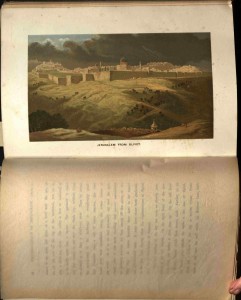 In a move that seems very far from the exuberant and absentminded processions of the earliest authors here assembled, Temple opens his preface by trying to specify the function of his book. “I desire,” he writes,
In a move that seems very far from the exuberant and absentminded processions of the earliest authors here assembled, Temple opens his preface by trying to specify the function of his book. “I desire,” he writes,
This introduction is a markedly humble, honest, and particular announcement of scope: the “real” place of Palestine is not being illustrated, rather the book depicts nothing more than Temple’s own journey—though each image is accompanied by a narration of topical “Scriptural events” so as “to set forth the subjects which are pictorially represented” (vi). Temple goes on to claim that his book exceeds other recent illustrated studies of Palestine, such as Picturesque Palestine, through the ad-
dition of colour, which “has something of novelty in it” (vii). Most curiously, Temple concludes his preface with a small miscellany of quotations from Ruskin because they “are so specially applicable to colouring in sacred scenery” (vii, emphasis added). In this first work in which coloured illustrations could be reproduced, colour becomes a quality that can enrich the holy, but which also attends graceful prose.
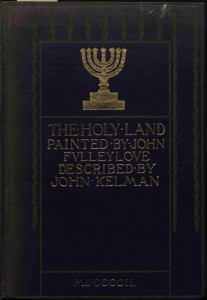
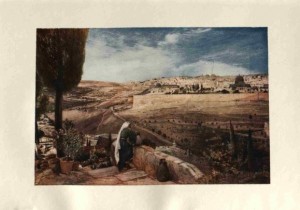 Kelman’s The Holy Land is embossed with a menorah although it is written from a Christian perspective. Its high-quality and well-preserved lithographic reproductions of paintings by John Fulleylove are the most colour-saturated and vivid images in this collection, and celebrate painterly rendering of landscape over photographic representation. Published as part of A.
Kelman’s The Holy Land is embossed with a menorah although it is written from a Christian perspective. Its high-quality and well-preserved lithographic reproductions of paintings by John Fulleylove are the most colour-saturated and vivid images in this collection, and celebrate painterly rendering of landscape over photographic representation. Published as part of A.
C. Black’s series, “Beautiful Books about the East,” Kelman’s book contains back-page advertisements for its other volumes.
Next Case: Palestine on Display
